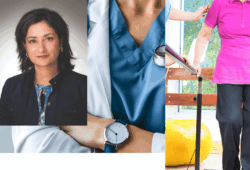How transparency, trust & a people-first culture are transforming an Alabama Health System
When Katrina Keefer joined DCH Health System in 2022 as its new CEO, she found an embattled, care-worn workforce. Years of serving on the front lines of a global pandemic, on top of developing endless efficiencies and process improvements, left caregivers feeling defeated.
To further compound the situation, the community formed a negative view of the Tuscaloosa, Alabama, health system, which they perceived as failing due to a lack of clarity from leadership and a glaring D safety grade from Leapfrog, an organization that measures and rates hospital quality.
With Keefer at the helm, DCH made a complete turnaround in just two years and is on the road to transformational excellence. How, you ask? “We did it through transparency with the community and giving credit to the frontline caregivers who had being doing good work,” she says.
Forging a path forward
“We did it through transparency with the community & giving credit to the frontline caregivers …”
DCH is what’s known as a sole community provider, with two hospitals operating under one provider number. This designation puts them in a better position to respond to healthcare’s ever-changing regulatory environment. But over the past five years, as DCH and the hospital industry struggled to bounce back from COVID, the people of Tuscaloosa grew frustrated with the culture and care quality, as well as the system’s financial outlook. Faith in leadership declined as communication lagged.
Keefer spent time listening and talking with community members. “I asked people about their experiences—the good and the bad,” she explains. “I wanted them to share with me so they can feel heard and we can improve. This simple act of listening to their needs and their concerns gave the community more confidence in the work we were doing to improve all facets of DCH.”
Seeing the link between staff morale and community perception, Keefer lifted caregivers by sharing stories of the extraordinary care DCH provides.
“I feel I have been able to give a voice to the great care happening here,” adds Keefer. “It has been a privilege to share our impact.”
Changing the culture
Another decision that made a key difference: Rather than search only nationally for leaders, Keefer promoted standout talent from within the organization and region. People who gave their all during the pandemic were given opportunities to move up and grow their influence.
Rachel Anderson is one of those leaders. She stepped into the Vice President of Supply Chain role at DCH in October 2024. Anderson had proven her capabilities at her previous employer, Baptist Health—where she and Keefer met—growing from Value Analysis Specialist to Corporate Director of Supply Chain over 13 years.
Keefer also felt Anderson was a strong cultural fit. Like Keefer, she takes pride in ensuring individuals in her home state receive high-quality care.
Anderson is helping shift the culture of the healthcare supply chain industry by championing education, visibility and leadership development. As a member of the Advisory Council for the Bellwether League Foundation (BLF)—a nonprofit dedicated to performance excellence in healthcare supply chain—she supports initiatives that not only recognize leaders but also foster future talent. Through academic scholarships, collegiate outreach and support for student-led projects, the BLF is helping build interest in supply chain careers.
As Chair of the BLF’s Professional Development Committee, Anderson leads creation of educational content such as panels, podcasts and fireside chats that highlight innovators and risk-takers. “By amplifying these voices and stories, I hope to drive a cultural shift—one that values bold thinking, mentorship and continuous professional growth across the supply chain landscape,” Anderson shares.
Her leadership style, like Keefer’s, is grounded in the belief that change begins by empowering individuals—through development, cultural transformation and helping every employee see their role in the mission of patient care.
Connecting the dots
Among the “Katrina-isms” staff have embraced, one stands out: “We are all caregivers,” Keefer says. “We value everyone’s place in the caregiving process.” This means thinking about the patient experience from A to Z—not just clinical service, but also scheduling orders and ensuring billing is accurate. Even non-clinical roles affect patient outcomes.
Helping employees clearly see their impact has brought unexpected wins like revenue improvements. “We have been able to make big strides in reducing denials and improving reimbursement rates,” she shares.
Using ratings to demonstrate progress
Hospital ratings like HCAHPS, Leapfrog, and U.S. News & World Report are often divisive. Keefer admits she had once been dismissive of Leapfrog. But in Tuscaloosa, the community really cared.
She saw that the hospital’s poor grade had confirmed public doubt. So Keefer leaned in. “Leapfrog is essentially an open-book test,” she says. “It’s all about demonstrating safer patient care.”
DCH focused on improving the safety and quality measures that Leapfrog uses. From 2021 to 2024, performance improved by 41%, from a D to a high B. Like many health systems, DCH had used Lean methodologies to cut waste and drive improvement. While often effective, a narrow focus on metrics can become exhausting and limit creativity.
“Instead of Lean textbook thinking, we tried to bring everyone to the table and consider their discipline and the downstream effects of a decision,” explains Keefer.
Growing great leaders
When hiring, Keefer emphasizes finding the right leader for each team, not just chasing impressive résumés. “We want a teamwork aspect for problem-solving,” she says. “So we look at where a candidate’s strengths might complement the team. Multidisciplinary and interdisciplinary teamwork have been the keys to success so far.”

Anderson agrees. “Since recently joining DCH, I’ve already been given the opportunity to sit in on hiring candidate interviews for other departments and to lend my voice to the selection process for our future leaders. I see us picking the right individuals to invest back into the organization,” she shares. “There is a positive, upward momentum across the health system and I can feel the enthusiasm amongst our staff as we work toward a common goal.”
Keefer also supports leadership growth across career stages. “We have leaders who are excellent within their departments and who want to grow in their knowledge and decision-making,” she says. “We look for opportunities for them to have exposure to other areas they may not have worked in previously. It’s about helping people stretch across disciplines so they become better leaders and gain perspective.” Leaders across departments and levels of seniority are encouraged to collaborate and solve problems together. The result: a culture where people feel safe raising concerns, asking questions and proposing ideas.
Anderson reflects on her own path. “I’m a prime example of someone who was given unique opportunities to learn and grow,” she explains. “I started as an intern with Baptist Health and was asked to aid in redesigning its Value Analysis Program, to focus on the importance of a cross-disciplinary approach and driving decision-making down into the organization. This gave me the opportunity to work with Quality, Nursing, Education, Infection Control, etc., and it was invaluable exposure that I wouldn’t have had otherwise. This experience and the promotion of multidisciplinary teamwork helped to shape, mold and ultimately propel my leadership journey forward.”
Mentoring future generations
Keefer and Anderson both believe that mentorship is a vital responsibility for leaders. At DCH, it’s also a core part of succession planning. “We encourage leaders to make time for the next generation—not necessarily young people, but those without the same title,” she says. “We are looking across all levels of the organization and encouraging them to stretch.”
“I’m passionate about mentoring the next generation & shining a light on healthcare supply chain as a destination career.”
Anderson echoes that belief. “The more I invest my time in helping others grow and learn,” she shares, “the more I grow as a leader myself. It’s a cycle of growth that benefits everyone involved.” Her leadership approach centers on the idea that success includes creating opportunities for others.
She currently serves as Board Liaison for the Association for Healthcare Resource and Materials Management’s Young Professionals Advisory Council (YPAC), which supports students and early-career professionals in the healthcare supply chain. YPAC provides input on programs and policies that support emerging leaders and fosters a Mentor-Mentee program designed to cultivate reciprocal, meaningful connections across experience levels.
“I’m passionate about mentoring the next generation and shining a light on healthcare supply chain as a destination career,” says Anderson. Her dedication to service aligns closely with Keefer’s leadership philosophy. And both leaders understand the importance of recognizing every role in the healthcare system as essential to the overall patient experience.
A symbiotic relationship
The community needs DCH for healthcare, and DCH needs the community’s support to stay viable. “There has been a lot of economic growth in Tuscaloosa, including international development, with Mercedes Benz located here,” explains Keefer. “We have so much to offer. It’s been great for the community and business leaders to be proud of DCH. This shift in perception has enabled us to recruit and retain top talent, both administrative and clinical.”
Share Email Employee Retention, Leadership, Q2 2025




